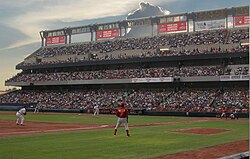피2 페가수스
Pi2 Pegasi| 관측 데이터 신기루 J2000.0 이쿼녹스 J2000.0 | |
|---|---|
| 별자리 | 페가수스 |
| 우측 상승 | 22h 09m 59.24371s[1] |
| 탈위임 | +33° 10′ 41.5976″ [1] |
| 겉보기 크기 (V) | +4.28[2] |
| 특성. | |
| 스펙트럼형 | F5 III[3] |
| B-V색지수 | 0.471±0.012[2] |
| 아스트로메트리 | |
| 방사 속도 (Rv) | +5.1±0.9km[2]/s |
| 고유 운동 (μ) | RA:−12.87±0.12[1]mas/yr Dec.:−18.95±0.16[1]mas/yr |
| 시차 (π) | 12.40 ± 0.17[1] 마스 |
| 거리 | 263 ± 4 리 (81 ± 1 pc) |
| 절대치수 (MV) | 0.21[4] |
| 세부 사항 | |
| 미사 | 2.48[5] M☉ |
| 반지름 | 8.5±0.8[6] R☉ |
| 루미도 | 102.9±2.6[6] L☉ |
| 온도 | 6,300+298 −263[6] K |
| 회전 속도 (v sin i) | 139.7km[4]/s |
| 나이 | 530Myr[5] |
| 기타 지정 | |
| 데이터베이스 참조 | |
| 심바드 | 자료 |
π2 페가수스자리(Pi2 Pegasi)는 라틴어로 페가수스자리(Pi Pegasi)로 북부 별자리에 있는 단일[8] 별이다.색조가 황백색이며 육안으로 볼 때 가시적 크기가 +4.28인 희미한 빛의 지점으로 보인다.[2]이 물체까지의 거리는 시차 기준 약 263광년이며,[1] 방사상 속도 +5 km/s로 더 멀리 떠내려가고 있다.[2]이 스타는 우르사 메이저 무빙 그룹의 외딴 멤버다.[9]
이 물체는 F5 III라는 별의 분류를 가지고 있어 중심부의 수소 공급이 소진된 후 주계열성을 냉각시키고 팽창시킨 노화된 거대 별과 일치한다.[3]현재 그것은 태양의 8.5배[6] 반경을 가지고 있다.이 별은 태양 질량의 2.48배로[5] 5억3천만년[5] 된 것이다.예상 회전속도는 140km/s로 진화 상태를 고려할 때 높은 회전율을 보인다.[4]그 별은 가능한 변광성 조개 항성으로 주목되어 왔다.[10]파이2 페가수스는 6,300K의 유효온도로 부풀어 오른 광권으로부터 태양의 103배의 광도를 방사하고 있다.[6]
참조
- ^ a b c d e f van Leeuwen, F. (November 2007), "Validation of the new Hipparcos reduction", Astronomy and Astrophysics, 474 (2): 653–664, arXiv:0708.1752, Bibcode:2007A&A...474..653V, doi:10.1051/0004-6361:20078357, S2CID 18759600
- ^ a b c d e Anderson, E.; Francis, Ch. (2012), "XHIP: An extended hipparcos compilation", Astronomy Letters, 38 (5): 331, arXiv:1108.4971, Bibcode:2012AstL...38..331A, doi:10.1134/S1063773712050015, S2CID 119257644.
- ^ a b Herbig, George H.; Spalding, John F., Jr. (January 1955), "Axial Rotation and Line Broadening in Stars of Spectral Types F0-K5", Astrophysical Journal, 121: 118, Bibcode:1955ApJ...121..118H, doi:10.1086/145969.
- ^ a b c Reiners, Ansgar (January 2006), "Rotation- and temperature-dependence of stellar latitudinal differential rotation", Astronomy and Astrophysics, 446 (1): 267–277, arXiv:astro-ph/0509399, Bibcode:2006A&A...446..267R, doi:10.1051/0004-6361:20053911, S2CID 8642707
- ^ a b c d Luck, R. Earle (September 2015), "Abundances in the Local Region. I. G and K Giants", The Astronomical Journal, 150 (3): 23, arXiv:1507.01466, Bibcode:2015AJ....150...88L, doi:10.1088/0004-6256/150/3/88, S2CID 118505114, 88.
- ^ a b c d e Brown, A. G. A.; et al. (Gaia collaboration) (August 2018). "Gaia Data Release 2: Summary of the contents and survey properties". Astronomy & Astrophysics. 616. A1. arXiv:1804.09365. Bibcode:2018A&A...616A...1G. doi:10.1051/0004-6361/201833051. 이 소스에 대한 가이아 DR2 기록 VizieR.
- ^ "pi02 Peg". SIMBAD. Centre de données astronomiques de Strasbourg. Retrieved 2019-10-11.
- ^ Eggleton, P. P.; Tokovinin, A. A. (September 2008), "A catalogue of multiplicity among bright stellar systems", Monthly Notices of the Royal Astronomical Society, 389 (2): 869–879, arXiv:0806.2878, Bibcode:2008MNRAS.389..869E, doi:10.1111/j.1365-2966.2008.13596.x, S2CID 14878976.
- ^ Chupina, N. V.; et al. (June 2006), "Kinematic structure of the corona of the Ursa Major flow found using proper motions and radial velocities of single stars", Astronomy and Astrophysics, 451 (3): 909–916, Bibcode:2006A&A...451..909C, doi:10.1051/0004-6361:20054009.
- ^ Hauck, B.; Jaschek, C. (February 2000), "A-shell stars in the Geneva system", Astronomy and Astrophysics, 354: 157–162, Bibcode:2000A&A...354..157H.
외부 링크
- Kaler, James B. "Pi Pegasi". Stars. University of Illinois. Retrieved 16 March 2016.




